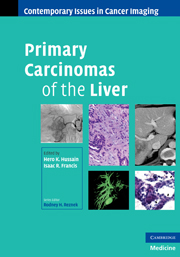Book contents
- Frontmatter
- Contents
- Contributors
- Series foreword
- Preface to Primary Carcinomas of the Liver
- 1 Epidemiology of hepatocellular carcinoma and cholangiocarcinoma
- 2 Surveillance and screening for hepatocellular carcinoma
- 3 Pathology of hepatocellular carcinoma, cholangiocarcinoma, and combined hepatocellular-cholangiocarcinoma
- 4 Radiological diagnosis of hepatocellular carcinoma
- 5 Staging of hepatocellular carcinoma
- 6 Surgical treatment of hepatocellular carcinoma: resection and transplantation
- 7 Non-surgical treatment of hepatocellular carcinoma
- 8 Radiological identification of residual and recurrent hepatocellular carcinoma
- 9 Radiological diagnosis of cholangiocarcinoma
- 10 Staging of cholangiocarcinoma
- 11 Treatment of cholangiocarcinoma
- 12 Uncommon hepatic tumors
- Index
- Color plates
- References
2 - Surveillance and screening for hepatocellular carcinoma
Published online by Cambridge University Press: 04 August 2010
- Frontmatter
- Contents
- Contributors
- Series foreword
- Preface to Primary Carcinomas of the Liver
- 1 Epidemiology of hepatocellular carcinoma and cholangiocarcinoma
- 2 Surveillance and screening for hepatocellular carcinoma
- 3 Pathology of hepatocellular carcinoma, cholangiocarcinoma, and combined hepatocellular-cholangiocarcinoma
- 4 Radiological diagnosis of hepatocellular carcinoma
- 5 Staging of hepatocellular carcinoma
- 6 Surgical treatment of hepatocellular carcinoma: resection and transplantation
- 7 Non-surgical treatment of hepatocellular carcinoma
- 8 Radiological identification of residual and recurrent hepatocellular carcinoma
- 9 Radiological diagnosis of cholangiocarcinoma
- 10 Staging of cholangiocarcinoma
- 11 Treatment of cholangiocarcinoma
- 12 Uncommon hepatic tumors
- Index
- Color plates
- References
Summary
The decision to screen an at-risk population for cancer is based on well-established criteria. Although the overall goal is to reduce morbidity and mortality from cancer, the objective of screening is to use a relatively simple and inexpensive test in a large number of individuals to determine whether they are likely or unlikely to have the cancer for which they are being screened. Screening is the one-time application of a test that allows detection of preclinical tumors, tumors at an early stage when they are asymptomatic with no clinical suspicion, and when curative intervention may achieve the goal of reducing morbidity and mortality. Surveillance is the continuous monitoring of disease occurrence (using the screening test) within a population to accomplish the same goals of screening. Criteria have been developed, first promoted by the World Health Organization, to assess the benefits of screening for a specific disease. This review will evaluate the process of screening/surveillance for hepatocellular carcinoma (HCC).
Cirrhosis has been recognized as the most important risk factor for the development of HCC. Hepatitis C (HCV) and hepatitis B (HBV) are the major etiological agents that lead to the development of HCC. HCV-associated cirrhosis is the causative agent that has been largely responsible for the increase in incidence of HCC in the United States. However, HBV is the leading cause of HCC worldwide, particularly in Asia and Africa. Therefore, there is a target population to which surveillance tests can be applied.
- Type
- Chapter
- Information
- Primary Carcinomas of the Liver , pp. 10 - 15Publisher: Cambridge University PressPrint publication year: 2009

